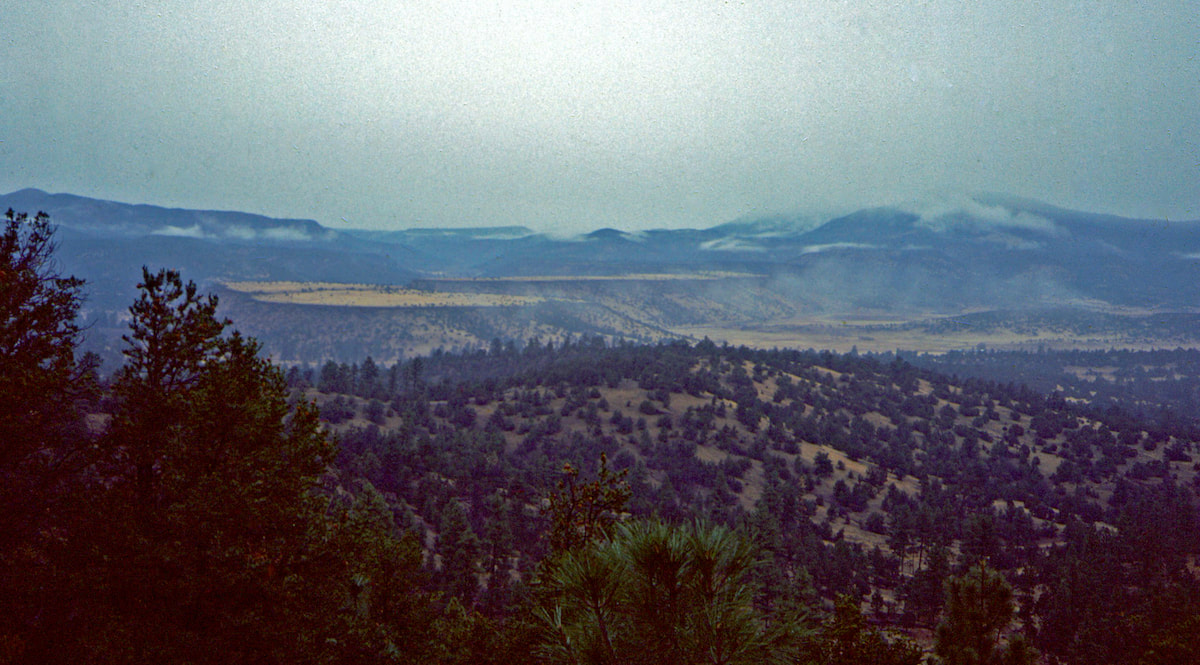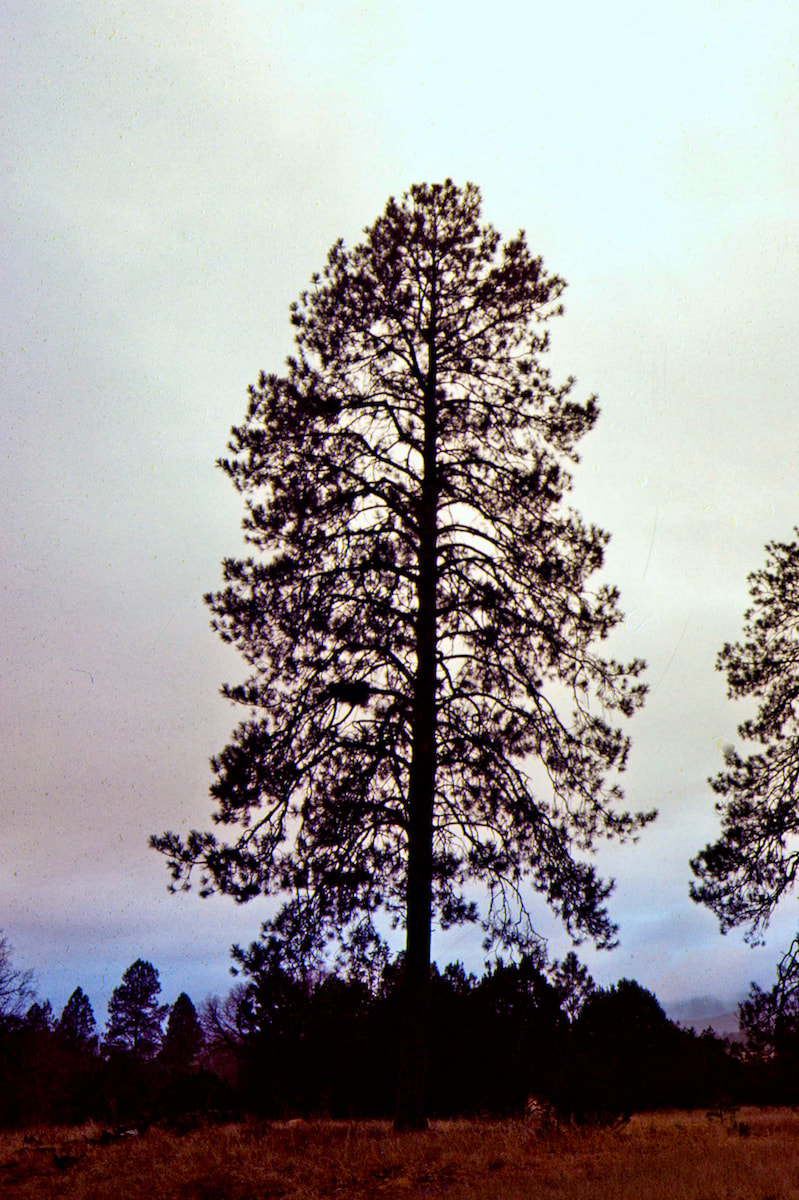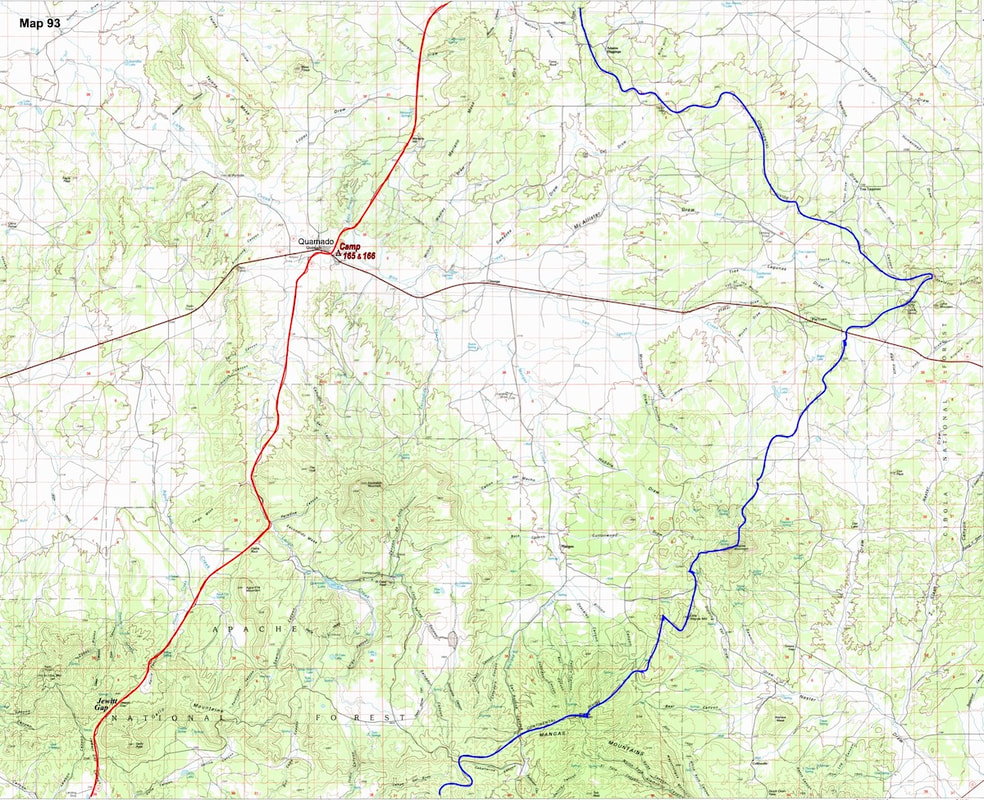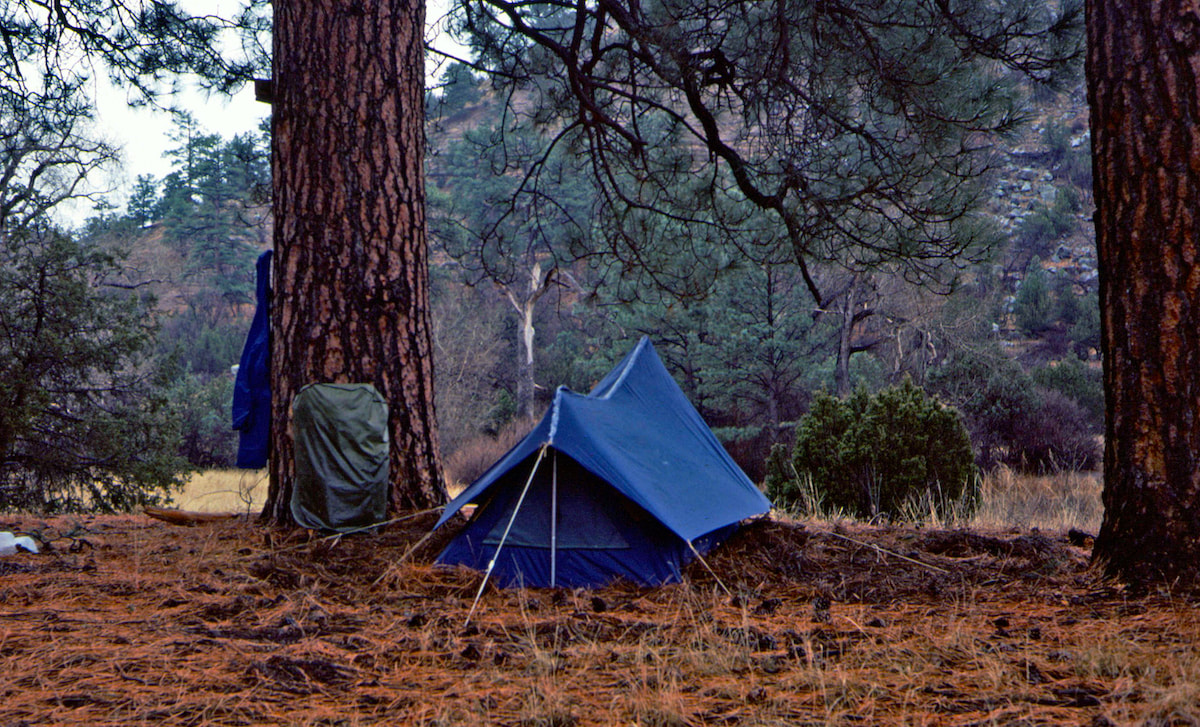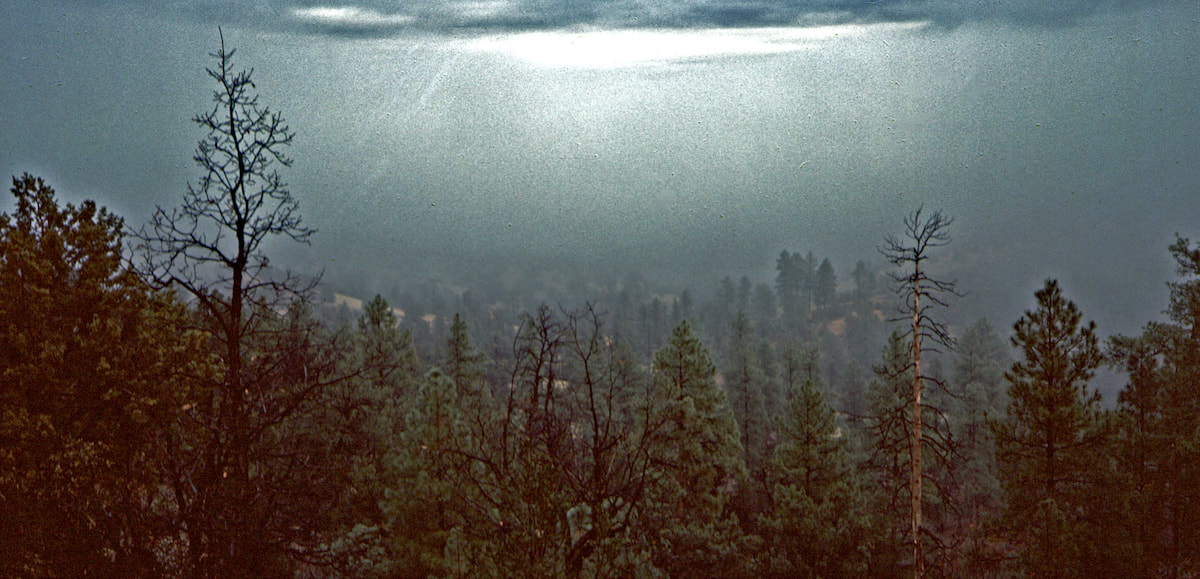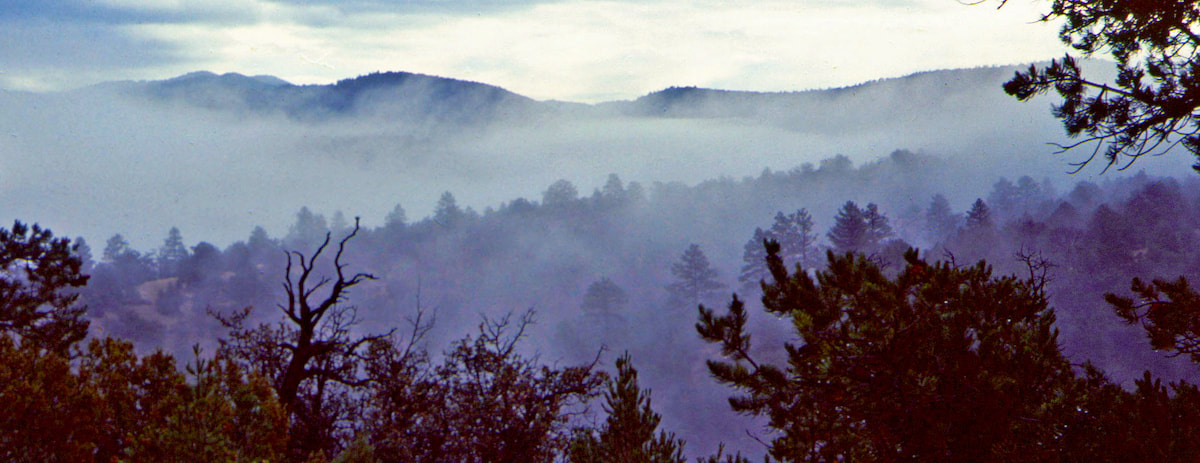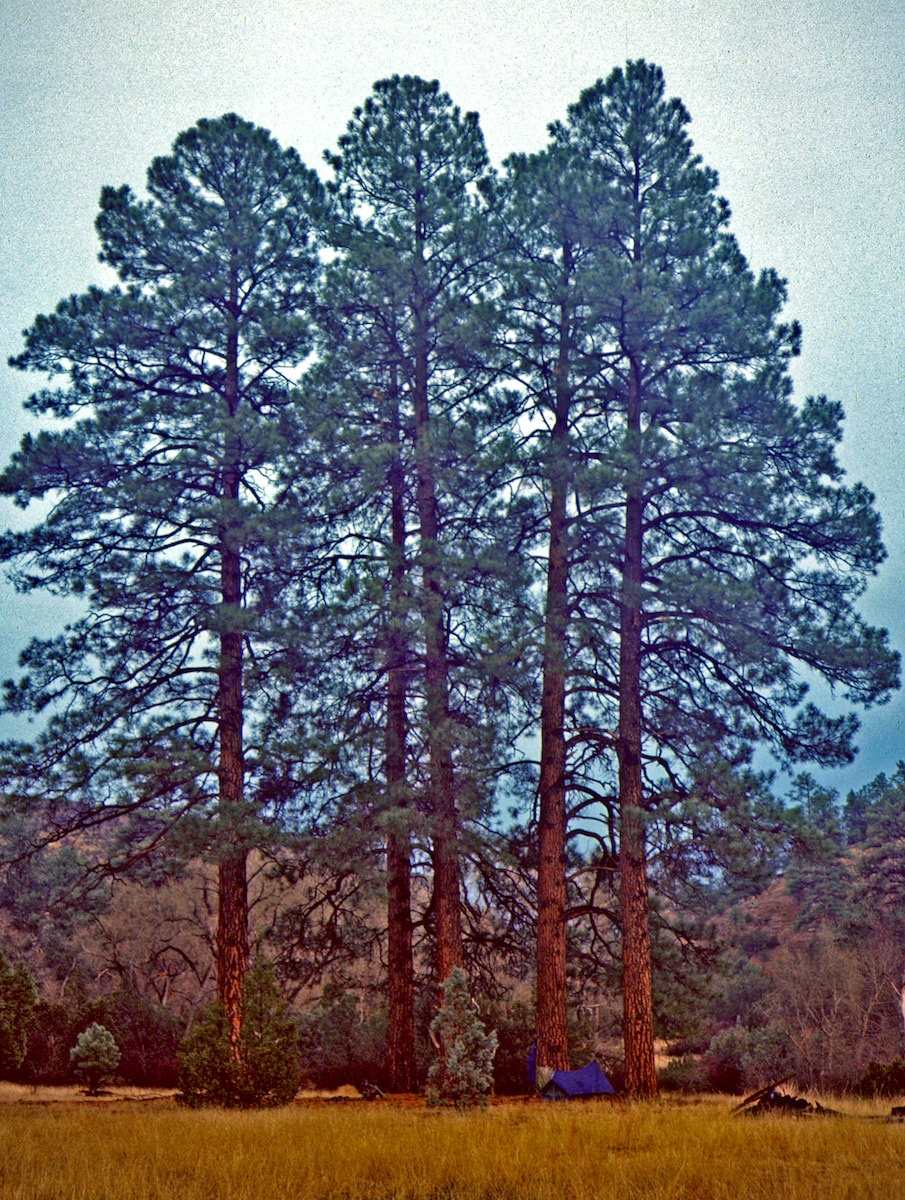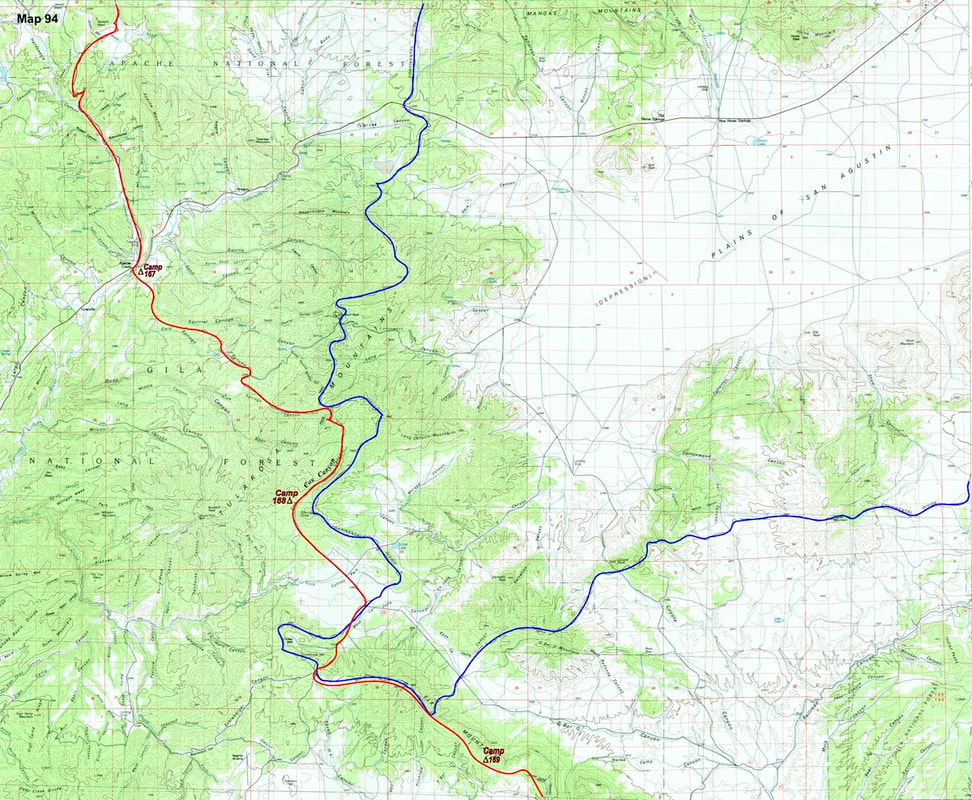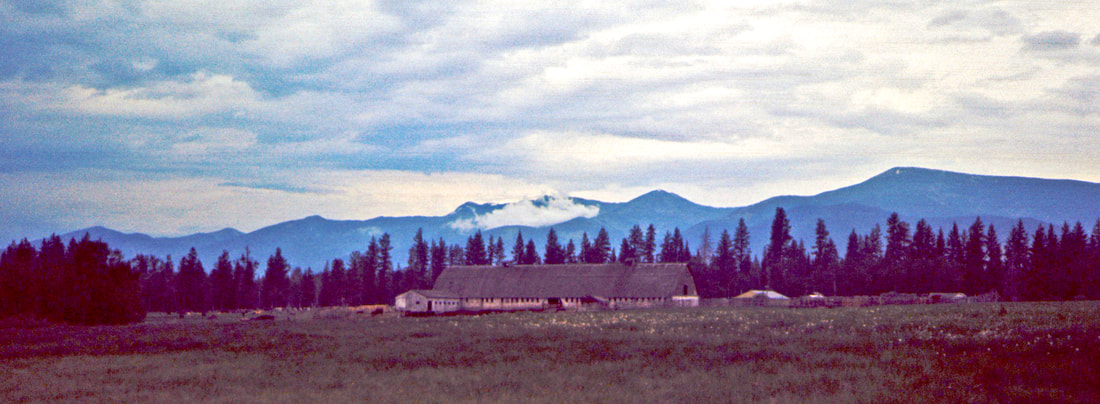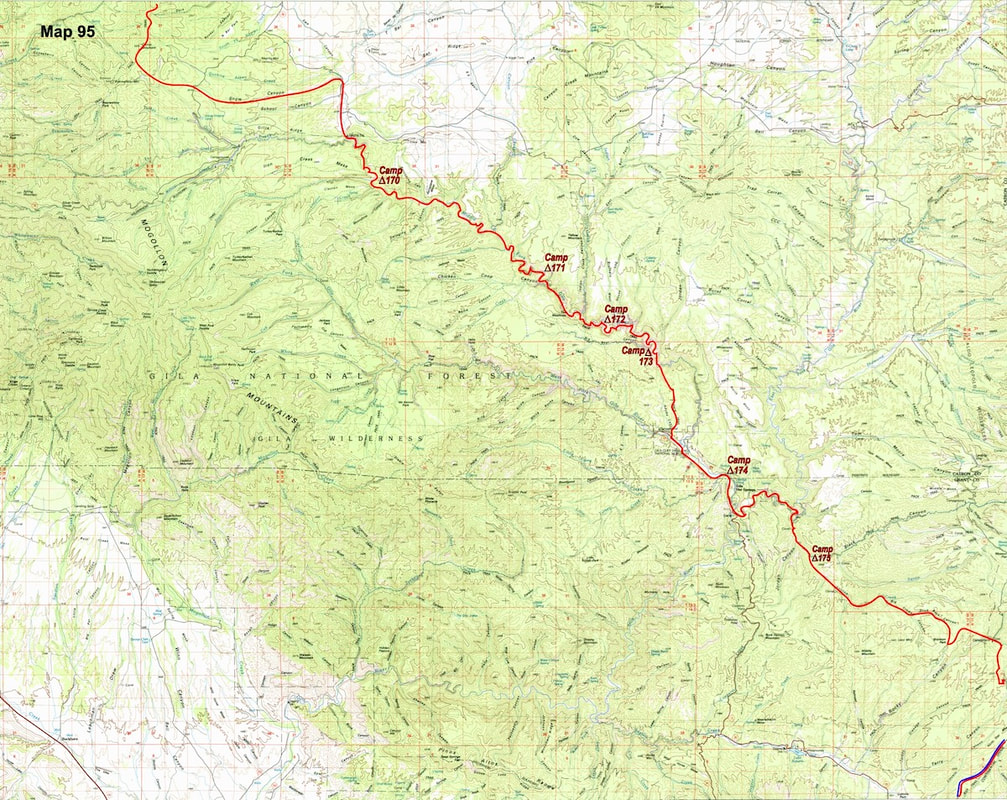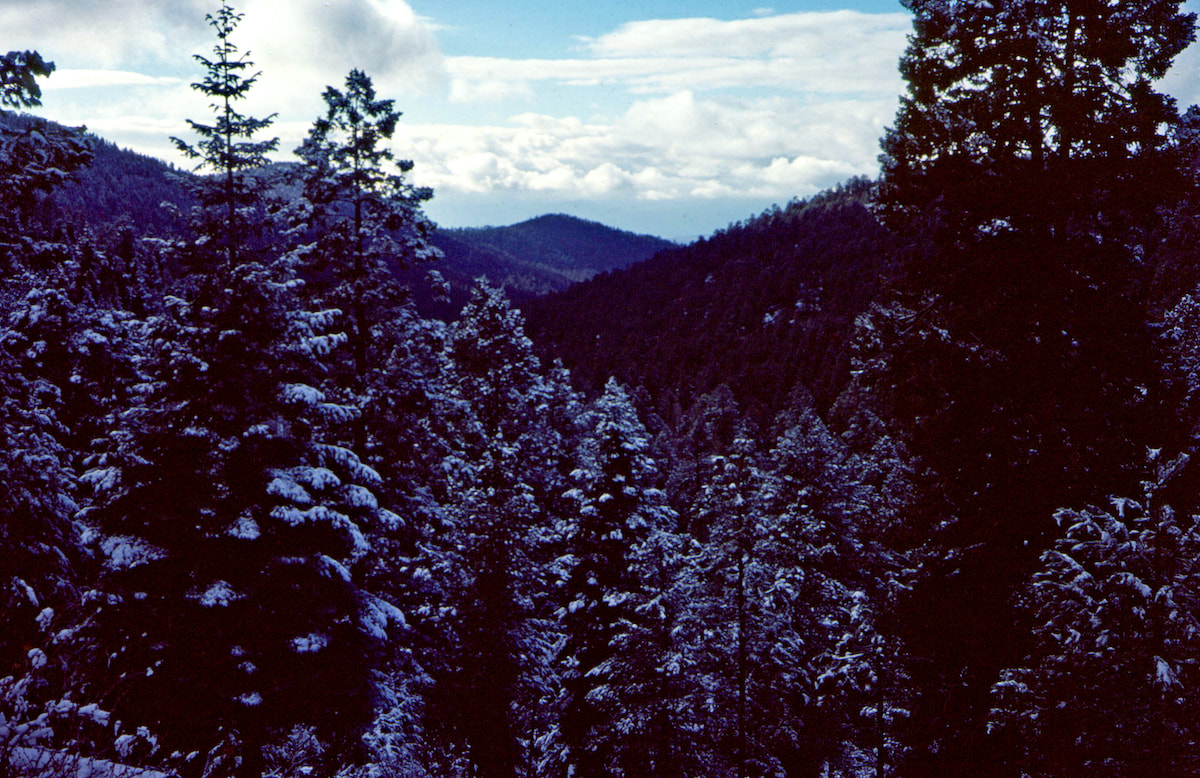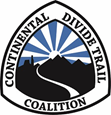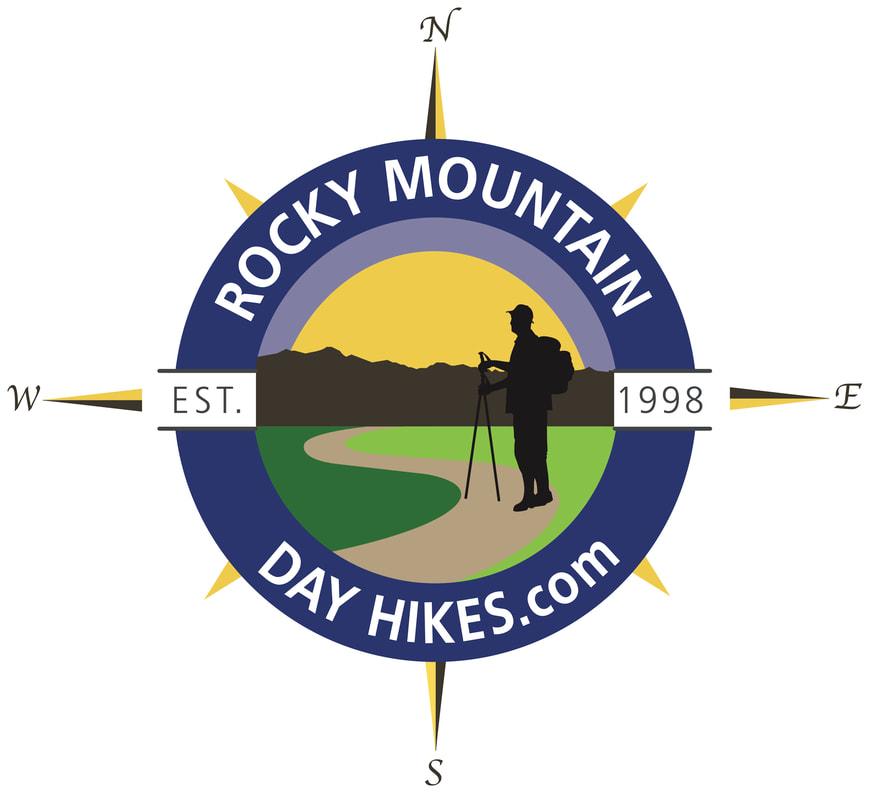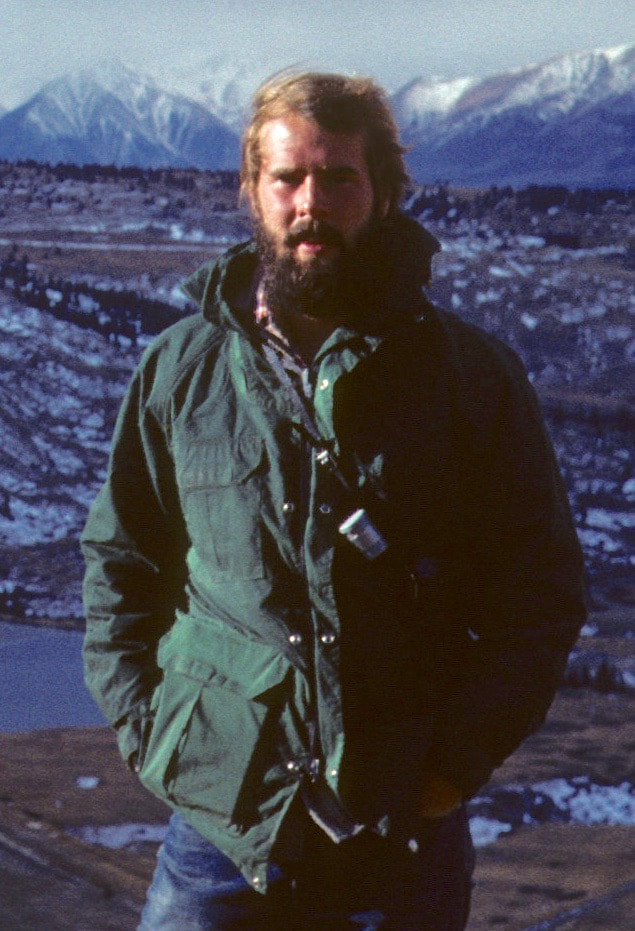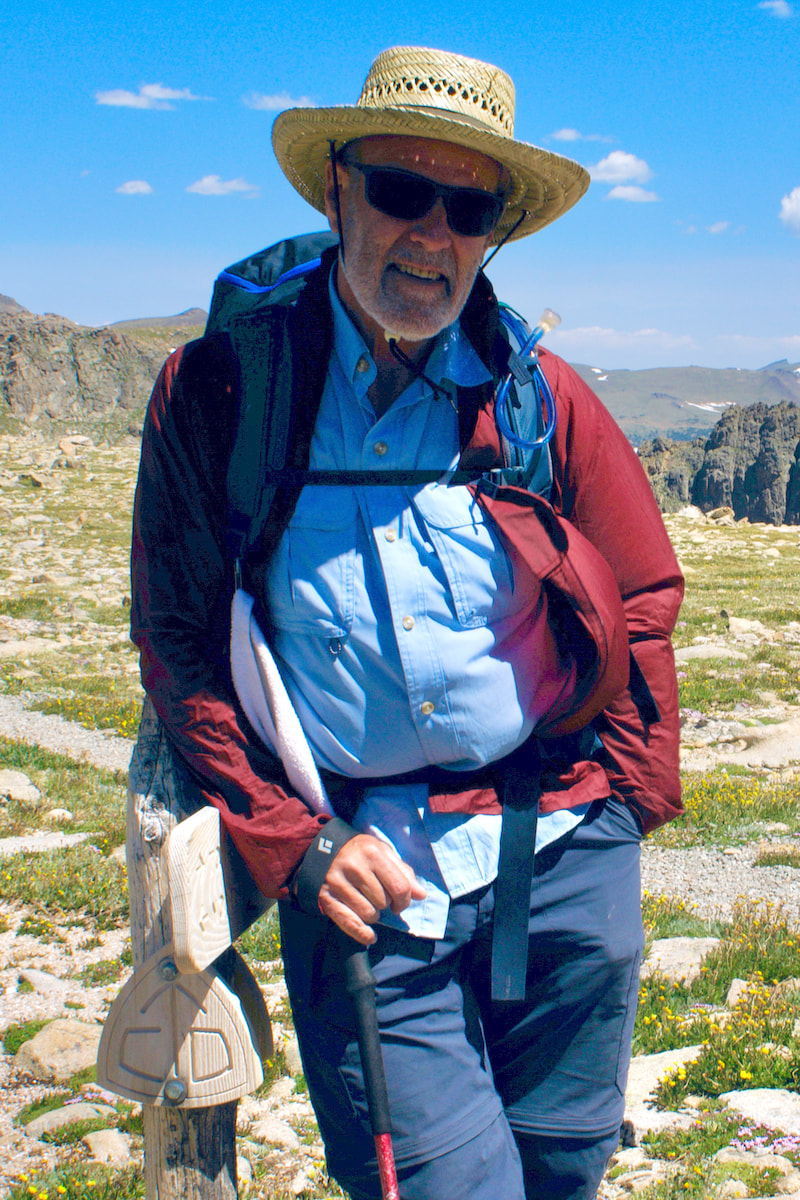The Continental
|
|
December 28th - 31st Quemado, NM (Go to Pt 1) I stayed over at the boarding house a second night and the following morning I was again disappointed in the weather, but it wasn’t exactly raining, either, and I was anxious to get out of town; shitty weather or not, I was behind schedule and had to move-on. I packed-up my stuff, placing the rain gear on top, and set-out from Quemado under heavy, wet skies. Recent rains had turned dirt to mud and the mucked-up road I was following climbed for several miles through a flat but ascending valley with sweeping mesas rising up on either side. Eventually, the two mesas converged to narrow the valley into a gorge and for the first time since leaving Chama I was back in tall pines with New Mexico’s, North Plains finally to the rear.
After crossing the river, I climbed up out of the valley along a narrow, flat ridge, separating two canyons. As I rose in elevation, the fog began to thin out just enough so that everything around me became visible but blurry, without definition, like walking through a watercolor. It was actually very cool and by the time I’d reached the ridgeline, I was floating between a sea of clouds below and a blanket of clouds above. While I’d been sitting in the rain down along the Tularosa River, snow had been falling at this elevation and I hiked through several inches while crossing the ridge over into Cox Canyon. By the time I had dropped into Cox Canyon, the lowland fog had dissipated but overhead, the thick clouds remained grumpy. Once in the canyon, I hiked a few more miles before coming out to a delightful campsite at the edge of a small meadow where making camp seemed like the right thing to do.
About an hour down the road my water worries relaxed when I spotted a holding tank not too far off, but when I got there I found the water iced over with a thick layer frozen across the top. ‘Godamit, it’s always something.’ I looked around and rustled-up a hefty rock with a jagged point to break through, then filled my containers with cold but stale water.
The trail I was following eventually ended at another jeep road which I decided to take since the road was also heading southeast along the ridge, the same as I was. I had been meandering along this jeep road for some time when I was suddenly jolted back into the moment by a pick-up truck bouncing its way toward me. I was surprised because I’d been following jeep roads through the hinterlands for nearly two weeks now and this was the first truck that I’d actually seen one on one of these roads. Naturally, I was curious as to where this truck was coming from, and the guy behind the wheel was at least as curious as to where I was going to. He pulled over, rolled down his window, and asked, “Hey, are you okay? You lost?” Mmm… “Where you headin’?” “The Gila River Canyon” I finally replied. The guy just grinned and looked me up and down like I was nuts. We chatted for a bit and when I told him I was walking to Mexico from Canada, the dude just grinned back at me like, ‘Yeah, right, and I’m driving to Mars.’ He let me know there was a firefighter’s base just a few more miles down the road but added, “You won’t find anything there, though, it’s all locked up for the season.” “Okay, thanks.” I replied. The guy pulled away but then stopped again and called out the window “Hey, how are you fixed for water? Do you need any?” Sure enough, I do. He only had a quart with him but was more than happy to pour it out into my water bottle, a gesture that made me realize I hadn’t met a single jerk on the entire trip; the people I’d met along the way had always been friendly and helpful. I made it to the firefighter’s base right around camping time and was pretty sure that the locked down facilities wouldn’t stop me from enjoying the amenities. The building looked to be an old army barracks and I went around trying windows until I found one that was unlocked. Yeah, baby! I climbed through the window, pulling my gear in after me, and set up shop on one of the bunks.
Finally descending from Elk Mountain’s southeast ridge, I dropped into Snow Canyon and was glad to finally find some water a little ways down in the gully. Snow Canyon did not last very long and I was rounding Snow Lake at the mouth of the canyon in short order, headed for the Gila River Canyon. Instead of mountaineering, I was going canyoneering. When Craig and I planned this trip to walk the crest of the continent, the last thing I expected was to end-up on a multi-day, canyon trek. However, I had been gambling with water sources ever since crossing over into New Mexico, so following the Gila River gave me a lifeline, free of water worries. Go to Part 85
0 Comments
Leave a Reply. |
Kip RuskIn 1977, Kip Rusk walked a route along the Continental Divide from Canada to Mexico. His nine month journey is one of the first, documented traverses of the US Continental Divide. Montana Part 1 - Glacier Ntl Pk Part 2 - May 11 Part 3 - May 15 Part 4 - May 19 Part 5 - May 21 Part 6 - May 24 Part 7 - May 26 Part 8 - June 2 Part 9 - June 5 Part 10 - June 7 Part 11 - June 8 Part 12 - June 11 Part 13 - June 12 Part 14 - June 15 Part 15 - June 19 Part 16 - June 23 Part 17 - June 25 Part 18 - June 27 Part 19 - June 30 Part 20 - July 5-6 Part 21 - July 7-8 Part 22 - July 9-10 Part 23 - July 11-15 Part 24 - July 17-18 Part 25 - July 18-19 Part 26 - July 19 Part 27 - July 20-21 Part 28 - July 22-23 Part 29 - July 24-26 Part 30 - July 26-30 Part 31 - July 31-Aug 1 Part 32 - Aug 1-4 Part 33 - Aug 4-6 Part 34 - Aug 6 Part 35 - Aug 7-9 Part 36 - Aug 9-10 Part 37 - Aug 10-13 Wyoming Part 38 - Aug 14 Part 39 - Aug 15-16 Part 40 - Aug 16-18 Part 41 - Aug 19-21 Part 42 - Aug 20-22 Part 43 - Aug 23-25 Part 44 - Aug 26-28 Part 45 - Aug 28-29 Part 46 - Aug 29-31 Part 47 - Sept 1-3 Part 48 - Sept 4-5 Part 49 - Sept 5-6 Part 50 - Sept 6-7 Part 51 - Sept 8-10 Part 52 - Sept 11-13 Part 53 - Sept 13-16 Part 54 - Sept 17-19 Part 55 --Sept 19-21 Part 56 Sept 21-23 Part 57 - Sept 23-25 Part 58 - Sept 26-26 Colorado Part 59 - Sept 26 Part 60 - Sept 30-Oct 3 Part 61 - Oct 3 Part 62 - Oct 4-6 Part 63 - Oct 6-7 Part 64 - Oct 8-10 Part 65 - Oct 10-12 Part 66 - Oct 11-13 Part 67 - Oct 13-15 Part 68 - Oct 15-19 Part 69 - Oct 21-23 Part 70 - Oct 23-28 Part 71 - Oct 27-Nov 3 Part 72 - Nov 3-5 Part 73 - Nov 6-8 Part 74 - Nov 9-17 Part 75 - Nov 19-20 Part 76 - Nov 21-26 Part 77 - Nov 26-30 Part 78 - Dec 1-3 New Mexico Part 79 - Dec 3-7 Part 80 - Dec 8-11 Part 81 - Dec 12-14 Part 82 - Dec 14-22 Part 83 - Dec 23-28 Part 84 - Dec 28-31 Part 85 - Dec 31-Jan2 Part 86 - Jan 2-6 Part 87 - Jan 6-12 Part 88 - Jan 12-13 Part 89 - Jan 13-16 Part 90 - Jan 16-17 Part 91 - Jan 17 End |
© Copyright 2025 Barefoot Publications, All Rights Reserved

